Ellen’s Sourdough Bread
14
Last updated on Dec 02, 2021
This post may include affiliate links. Thank you for your support.
A beginner’s guide to making sourdough bread! This simple, no-knead recipe is easy to make with your sourdough starter. Just let the dough rise overnight and bake in the morning!
My mother-in-law, Ellen, is most famous for her challah and chocolate chip cake, but during quarantine she taught herself how to make sourdough bread as well and she has totally mastered the perfect loaf!
She bakes sourdough bread a few times a week and always offers us a loaf! And yes, we realize how lucky we are to have on-demand fresh sourdough! Everyone loves it (including Olivia). Isaac and I eat toasted sourdough bread with avocado or peanut butter for breakfast on the daily. It’s amazing.
I’ve shared about her sourdough on Instagram and have been asked for the recipe numerous times. Luckily, Ellen was willing to share her recipe when I asked. She came over multiple times to show me the process and let me take photos so I could learn the ropes and put together a step-by-step guide for you! I also took video clips so I’ll be sharing that soon as well.
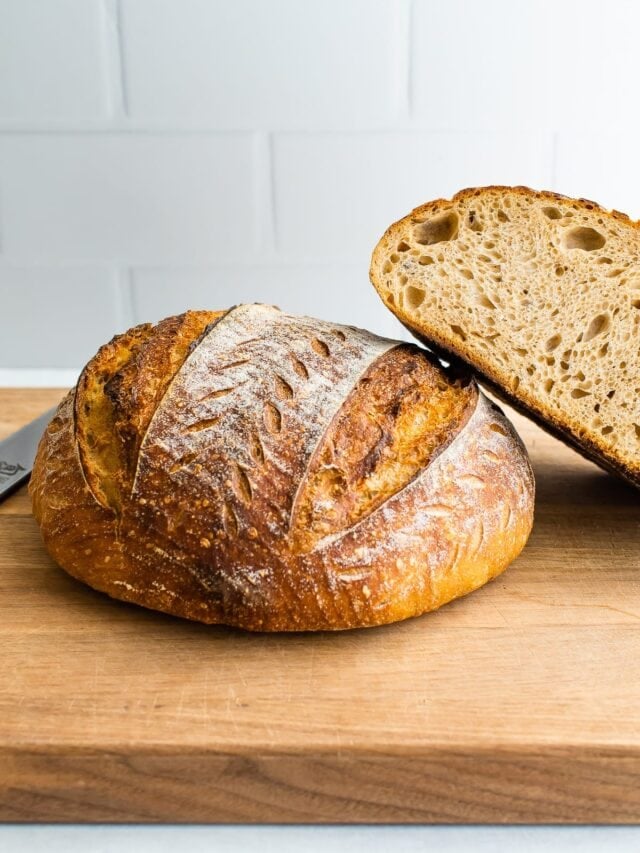
I should also note that there are a ton of different sourdough bread recipes out there, this is just the recipe that Ellen has perfected. It works with her schedule and results in a delicious loaf every time! It’s honestly some of the best sourdough bread I’ve ever tasted, even better than bakery sourdough bread!
If you’ve never made sourdough before, you’re in the right spot! Let’s walk through this together.
Okay, so What is Sourdough Bread?
For starters (pun intended) let’s talk about what exactly sourdough bread is. At a basic level, sourdough is a naturally leavened bread that’s made with a fermented sourdough starter rather than commercial yeast. During the fermentation process, wild yeast and bacteria breakdown gluten and sugar and turn them into minerals, vitamins, and protein. Because of this, sourdough is also known as wild-yeasted or fermented bread.
Is Sourdough Bread Healthy?
Sourdough is one of the healthiest breads you can eat! First, it is good for gut-health because the fermentation process gives sourdough prebiotic and probiotic-like properties. It’s also easier to digest, especially if you’re sensitive to gluten, because much of the gluten is broken down during the process of making sourdough.
Sourdough also has a lower glycemic index than white bread or whole-wheat bread that isn’t fermented. Lastly, it’s packed with nutrients, healthy carbs, protein, fiber and vitamins like folate and iron! Read more about the nutrition facts and health benefits of sourdough.
Sourdough Starter
To make sourdough bread, you need sourdough starter! This is a live, fermented flour and water mixture that contains wild yeast and good bacteria. The sourdough starter acts as a leavening agent and replaces the need for commercial yeast when making bread.
You can make your own starter, buy a starter or get one from a friend who is also making sourdough bread. Ellen actually made her own starter using the sourdough starter recipe from King Arthur.
Lots of people treat their sourdough starter like a pet and give it name and everything. I’ll have to ask Ellen if her starter has a name!
The cool thing about having a sourdough starter is that you can you make a ton of different recipes with it, not just bread! I’ve seen recipes for sourdough bagels, sourdough pancakes and sourdough cinnamon rolls!
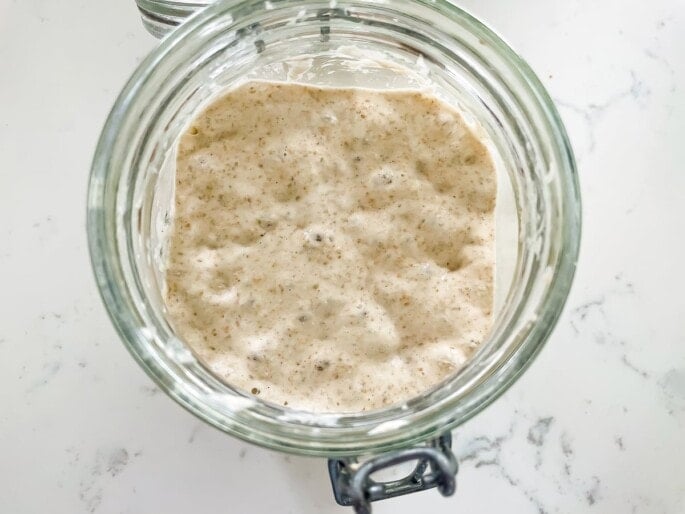
Feeding Your Sourdough Starter
One thing to know about sourdough starters is that you have to feed (aka refresh) them. This means that you’ll be measuring out a portion of the starter and adding more flour and water to it.
To keep it simple, Ellen uses a 1:1:1 ratio: she measures out 100-110 grams of starter and then adds 100-110 grams warm water (warmed to about 80 degrees) and 100-110 grams of all purpose flour.
You’ll want to feed your starter (and have it double in size) before you bake. Ellen feeds her starter 2-3 times a week because she is baking sourdough a few times a week, but your feeding schedule will vary based on how often you’re baking.
When you feed your starter, any amount of starter leftover after measuring the 100-110 grams is called sourdough discard. As the name suggests, you can discard it (compost or toss), but if you’d rather it not go to waste (I commend you) there are a ton of great sourdough discard recipes as well! I know Ellen has made sourdough discard crackers and sourdough English muffins.
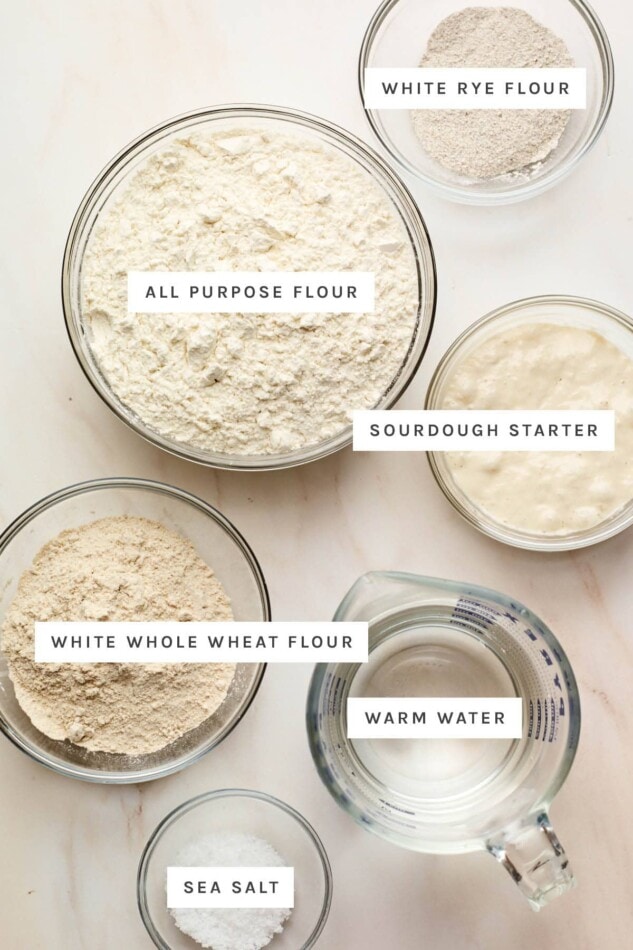
Sourdough Bread Ingredients
Here’s what you’ll need to make this sourdough bread recipe!
- water – tap water is fine. If you have a thermometer you’ll want the water at 80°- 82°F.
- sourdough starter – read the notes above about making your own sourdough starter.
- all purpose flour – Ellen recommends King Arthur all purpose flour.
- rye flour – Ellen recommends King Arthur rye flour and we really like the flavor that this gives the bread, but you can use more all purpose or more white whole wheat flour if you don’t have rye or don’t want to use it.
- white whole wheat flour – white whole wheat and traditional whole wheat are both 100% whole wheat, but white whole wheat is made from white wheat berries and traditional whole wheat is made from red wheat berries. No surprise here, Ellen uses King Arthur white whole wheat flour as well.
- fine sea salt – salt enhances the flavor of sourdough bread and helps slow the fermentation process down slightly.
Equipment Needed
- Cast iron Dutch oven – you’ll need some sort of Dutch oven for baking sourdough. I have a 5.5 quart Le Creuset Dutch oven that I love. (We got it as a wedding gift.) This Lodge enameled Dutch oven is reasonably priced and very pretty.
- UFO round lame – this is what you’ll use to score the bread and give it a beautiful design. Ellen said that this round lame is so much easier to control than the long handle ones.
- 4 Quart Cambro with lid – you can use a mixing bowl to make the dough and let it rise, but Ellen prefers using a Cambro for the bulk rise of the dough. It’s easy to store and you can wrap a rubber band around it to keep track of the rise.
- Banneton baskets – there are a lot of Banneton baskets on Amazon to chose from. I suggest either a set of two 8.5″ rounds or you can find sets with a 8.5″ or 9″ round and a 10″ oval. Ellen likes having one of each.
- Kitchen scale – a kitchen scale is really helpful when baking things like sourdough and they’re pretty inexpensive. Here’s the kitchen scale that Ellen has!
- Kitchen thermometer – a kitchen thermometer isn’t essential but it can be helpful for checking the temperature of the water you’re using as well as making sure your bread is done. And I’m sure you’ll find other uses for it as well!
- Weck jar – Weck glass jars are pretty and perfect for keeping your sourdough starter. The 1 liter jar is a good size for rising.
Step-By-Step Process for Making Sourdough Bread
Day 1 (Start in the Morning)
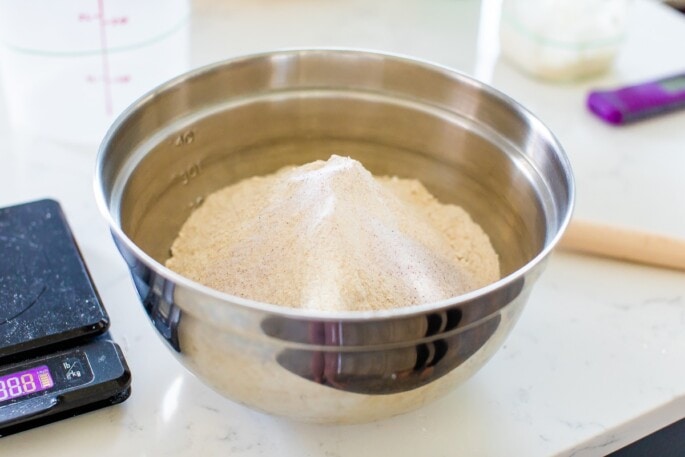
Measure out the flours using a food scale. Using a food scale helps to ensure that you’re getting the proper measurements!
tip! Be sure to zero out the weight of the bowl!
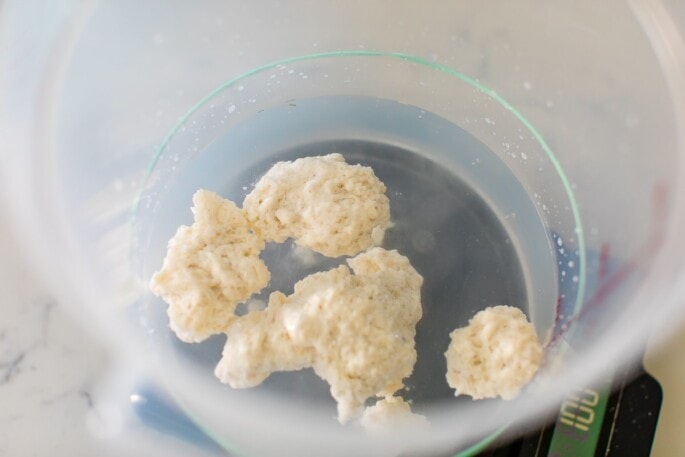
Add water, sourdough starter, salt and flours together in Cambro or large mixing bowl. Ellen recommends using a food scale to measure the sourdough starter for a more exact measurement.
Use your hands to mix the ingredients together. The dough will look “shaggy” at this point. Just mix until all the flour is combined. Cover using the lid of the Cambro or a kitchen towel and leave for 15 minutes.
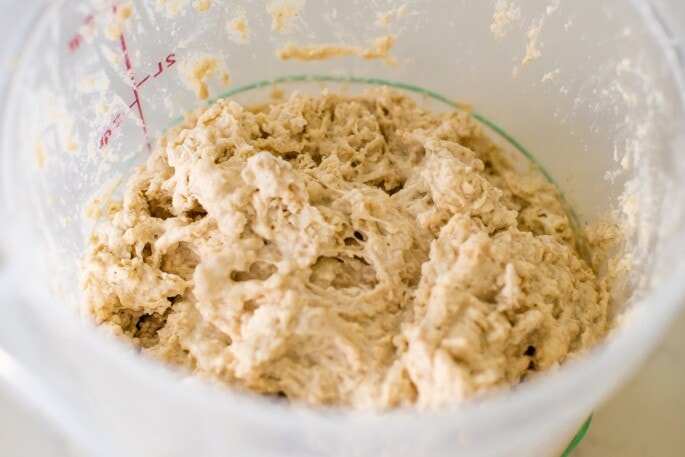
Open Cambro and “stretch and fold” the dough, cover and wait another 15 minutes. Repeat until you have done four total “stretch and folds.” The dough should then be smooth and should have lots of stretch by the last stretch.
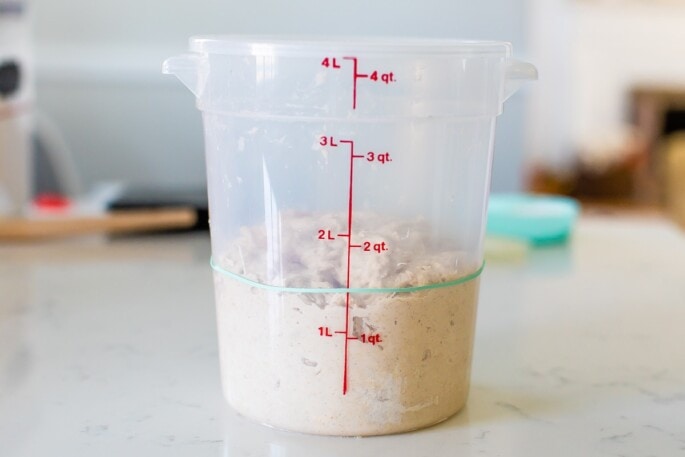
Cover tightly and leave the dough a room temperature until it has doubled in size (the easiest way to measure is put a rubber band around Cambro where dough starts). This can take 6-8 hours in the summer and 10-12 hours in the winter here in Virginia.
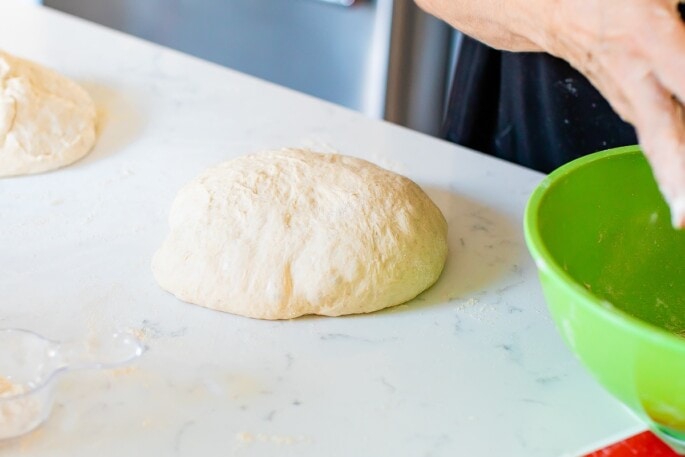
After it has doubled, you’ll remove the dough from Cambro and place it onto a lightly floured surface. A granite or quartz countertop will work great or you can use a large silicone mat. Divide the dough in half, and shape into two rounds. They should be a little over 900 grams each.
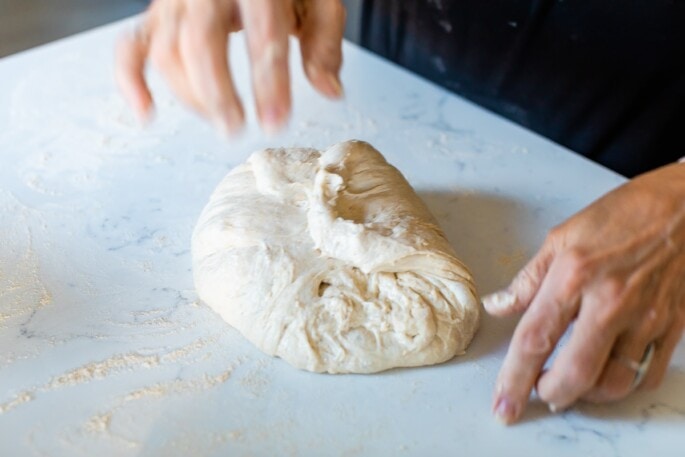
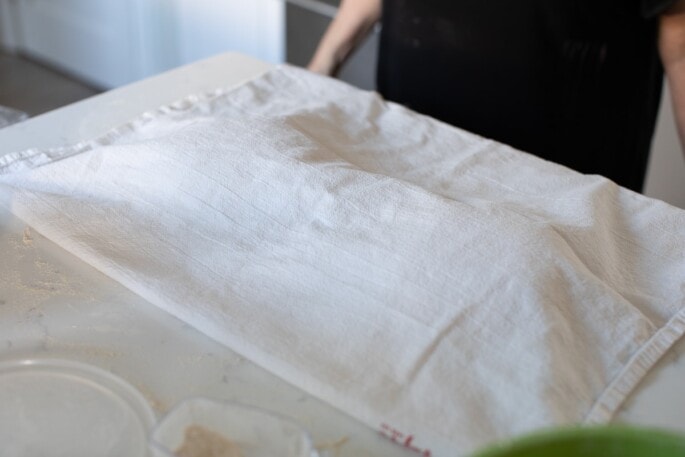
Take each round and pull edges to center all the way around, then flip over and cover with a tea towel for 10 minutes.
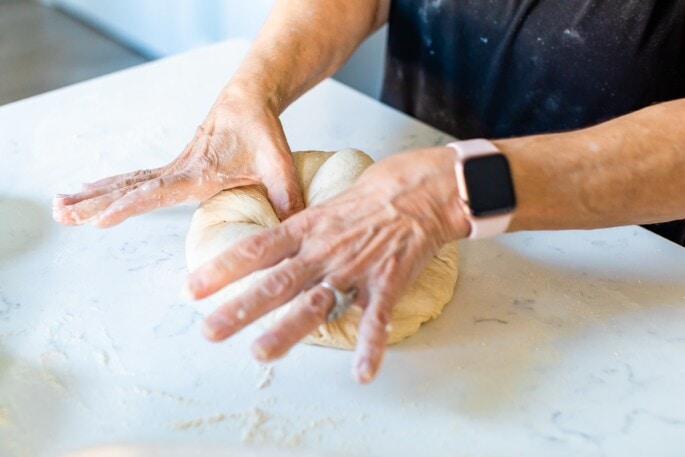
Do the same thing again, pulling edges out a little. Tuck into the center and flip the round over.
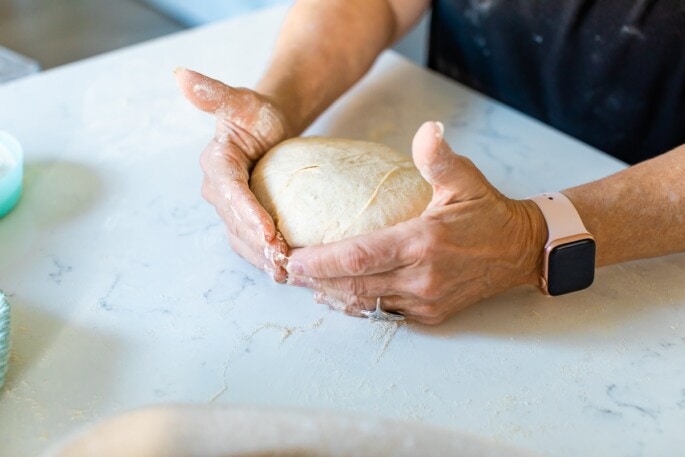
Then take round and gently pull a few inches toward you. You can do this 3 or 4 times and feel the form “tighten” a little. Lift, flip over and place into a banneton basket.
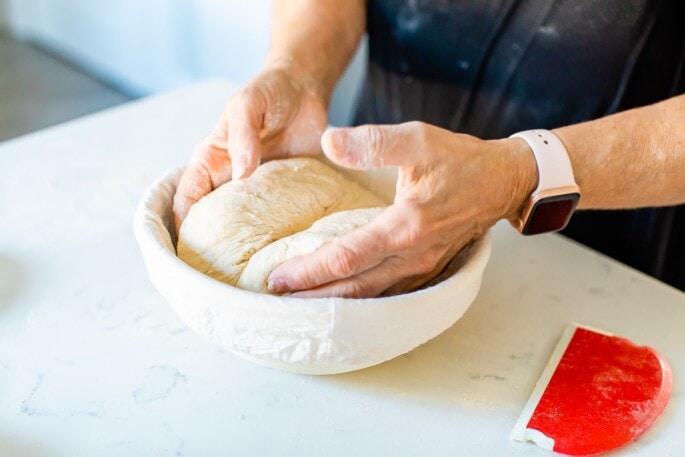
Cover basket(s) and put into the fridge overnight.
Day 2 (Ready to bake!!!)
Put a cast-iron Dutch oven (two if you have them) in the oven and heat at 500 degrees for 30 minutes.
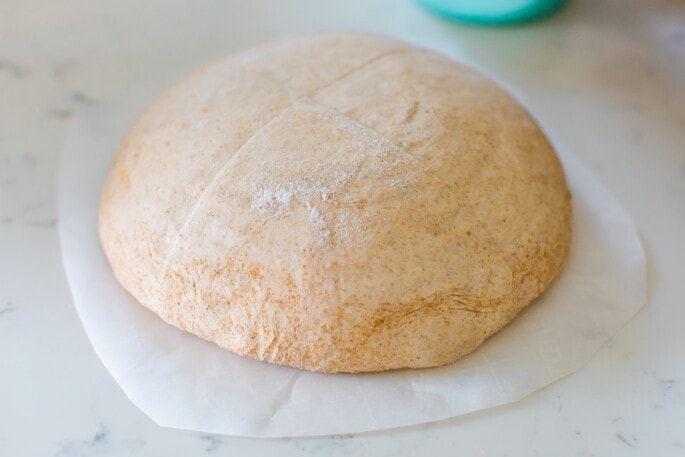
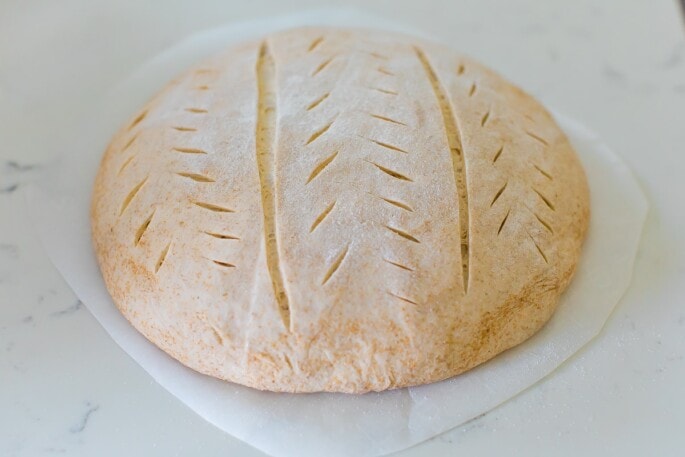
Take one loaf out of the fridge, flip it over onto parchment, sprinkle on a little rice flour (optional), score and put into the preheated dutch oven. If you have two Dutch ovens, repeat with the second loaf otherwise wait to score the second loaf until the first one is done baking.
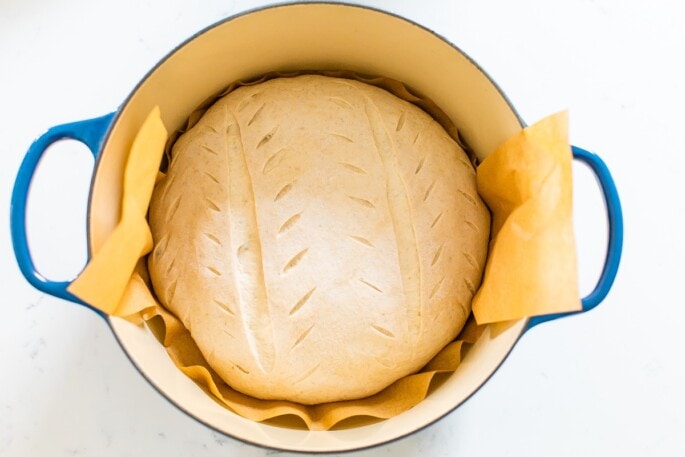
Reduce heat to 450°F degrees and bake 20-23 minutes covered, then uncover and bake another 20 minutes. When done, it will have a hollow sound if you tap it and a nice crunch if you push on it gently. If you have a thermometer you can check for internal temperature of 220°F.
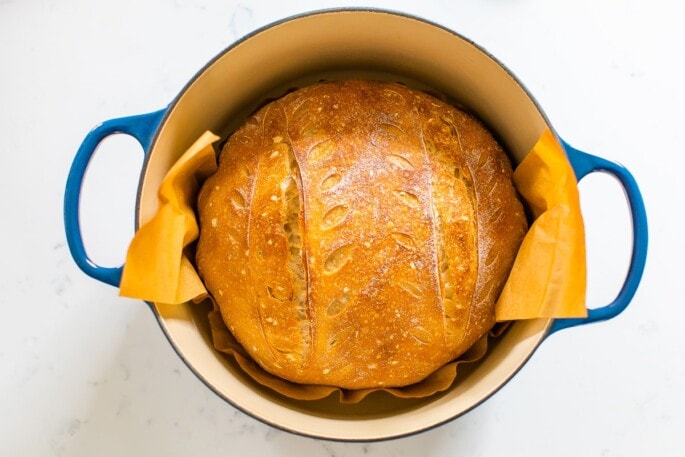
Folding the Dough (Don’t Knead)
When baking bread, you typically knead it to activate the gluten. With sourdough, you actually want to stretch and fold the dough rather than knead it to create that airy texture we all know and love about sourdough.
To stretch and fold the dough, take a portion of the dough and stretch it upward. Fold the stretched portion of the dough over toward the middle of the bowl or Cambro. Turn the bowl a quarter turn and repeat. Continue this until you have stretched and folded all four “sides”. The dough should then look smooth instead of shaggy and should have lots of stretch by the last stretch.
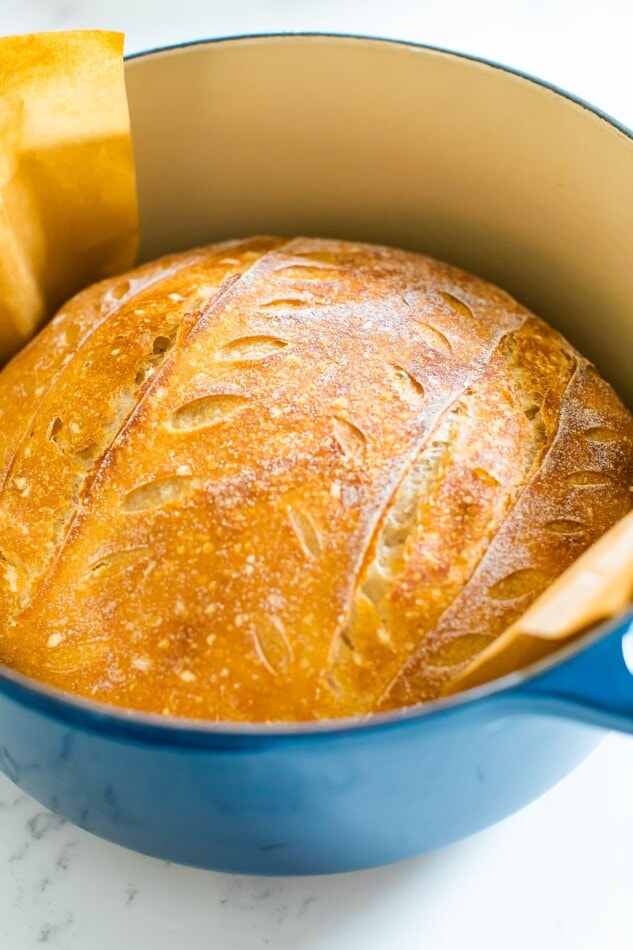
Sourdough Bread FAQ
Through lots of trial and error, Ellen found that King Arthur Flour is best for making sourdough! It’s a high-quality brand with a high protein content (which helps the gluten form well!). She found that off-brands and store brands sometimes effect the hydration so you may need to adjust with more or less flour.
Ellen recommends using a Dutch oven because it creates a mini steam oven. It basically traps in heat and moisture which is necessary for sourdough baking.
Yes, most recipes are just plain flour, water and salt, all of which are vegan. Of course, you’ll want to check the ingredients or ask about the ingredients when purchasing a loaf.
No, most sourdough bread recipes use regular flour, which isn’t gluten-free. Here’s a gluten-free sourdough recipe!
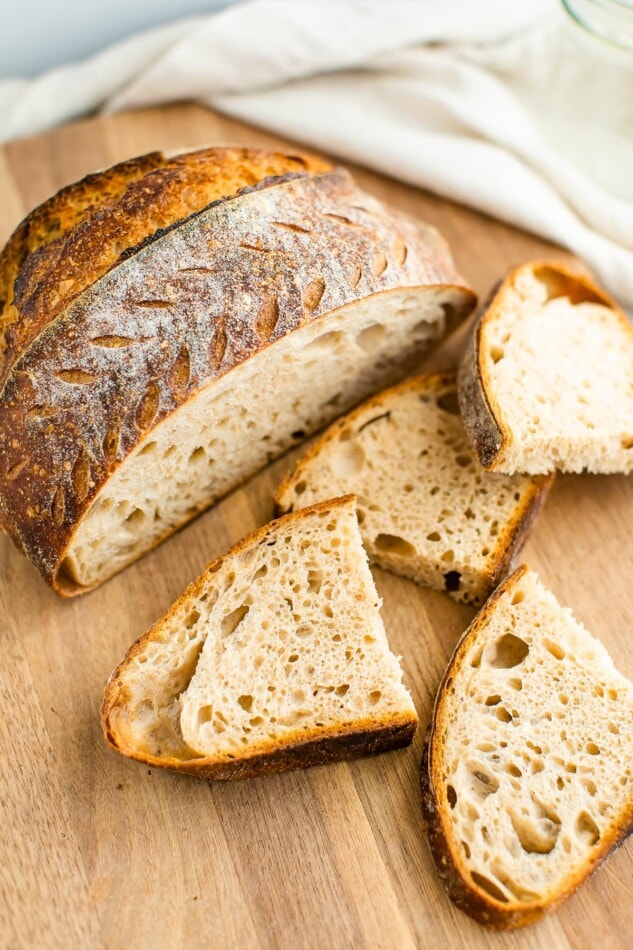
How to Enjoy + What to Serve With Sourdough Bread
Sourdough bread is delicious on its own. It has a soft inside with a hard outer crust. It can be sliced or torn apart and served with butter or oil, but I definitely think it tastes best when toasted! Here are a few ways I love to enjoy it:
- Peanut butter toast – we make peanut butter toast with fresh fruit like banana slices, figs or pears on top and it’s so tasty. It’s also delicious with a spread of fig jam, chia jam or as a base for pesto eggs!
- Avocado toast – sourdough is the perfect bread for making avocado toast. Just toast a slice of sourdough, add avocado and a sprinkle of sea salt or everything bagel seasoning and enjoy.
- Open faced sandwiches – You can certainly use crusty sourdough bread for traditional sandwiches, but for me it feels a bit too bulky with two slices (and it cuts the roof of my mouth) so I like to use toasted sourdough for open faced sandwiches. Ellen makes an amazing sourdough sandwich bread as well so we just use that for regular sandwiches.
- With soup – toasted sourdough is amazing served with soup. We love to dip it into my tomato basil soup, vegetable soup or this chicken wild rice soup but it can be served with any of my soup recipes. It also works great as a bread bowl!
Popular Bread Recipes
- Healthy Banana Bread
- Vegan Cornbread
- Healthy Fig Bread
- Whole Wheat Irish Soda Bread
- Healthy Zucchini Bread
If you enjoyed this recipe, please consider leaving a ⭐ star rating and let me know how it went in the 📝 comments below.
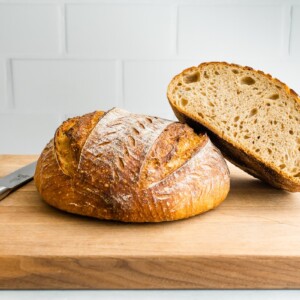
How to Make Sourdough Bread
Ingredients
- 750 grams warm/tepid water*
- 100 grams sourdough starter (⅓ cup)
- 750 grams King Arthur all purpose flour
- 50 grams King Arthur rye flour
- 200 grams King Arthur white whole wheat flour
- 20 grams sea salt
- rice flour, to sprinkle on top before baking (optional)
Instructions
Day 1 (Start in the Morning)
- Measure out the flours using a food scale. Using a food scale helps to ensure that your getting the proper measurements!
- Add water, sourdough starter, salt and flours together in Cambro or large mixing bowl and use your hands to mix the ingredients together. Dough will be “shaggy”, just mix until all the flour is combined. Cover and leave for 15 minutes.
- Open Cambro and “stretch and fold” the dough, cover and wait another 15 minutes. Repeat until you have done four total "stretch and folds." Dough should then be smooth and should have lots of stretch by the last stretch.
- Cover tightly and leave the dough a room temperature until it has doubled in size (easiest way to measure is put a rubber band around Cambro where dough starts). This can take 6-8 hours in the summer and 10-12 hours in the winter!
- Remove dough from Cambro and place on onto lightly floured surface. A granite counter top work great or use a silicone mat. Divide dough in half (should be a little over 900 grams each).
- Take each round and pull edges to center all the way around, then flip over and cover with a tea towel for 10 minutes. Do the same thing, pulling edges out a little and tuck into center and flip over. Then take round and gently pull a few inches toward you. You can do this 3 or 4 times and feel the form “tighten” a little. Lift and flip over and place into banneton baskets.
- Cover and put into fridge overnight.
Day 2 (Ready to Bake!!!)
- Put a cast-iron Dutch oven (two if you have them) in the oven and heat at 500 degrees for 30 minutes. Take one loaf out of the fridge, flip over onto parchment, sprinkle on a little rice flour, score and put into the preheated dutch oven. If you have two Dutch ovens, repeat with second loaf otherwise wait to score the second loaf until the first one is done baking.
- Reduce heat to 450°F degrees and bake 20-23 minutes covered, then uncover and bake another 20 minutes. When done, it will have a hollow sound if you tap it and a nice crunch if you push on it gently. If you have a thermometer you can check for internal temperature of 220°F.
Notes
- If you have a thermometer, you’ll want to make sure the water is around 80°- 82°F.
Nutrition
Nutrition information is automatically calculated, so should only be used as an approximation.
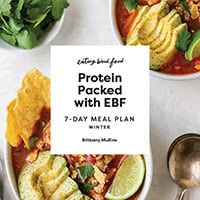
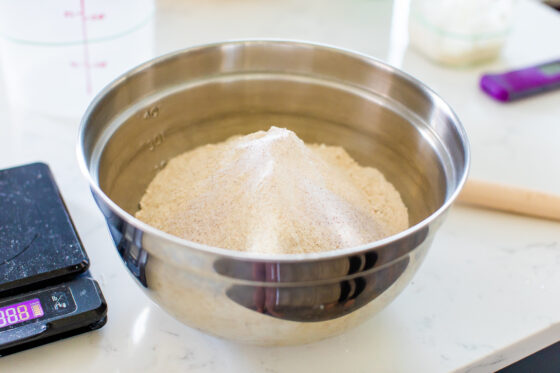
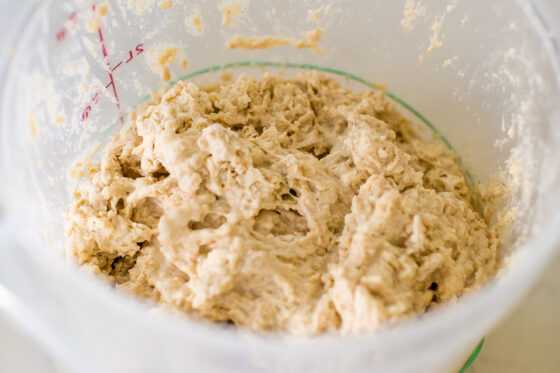
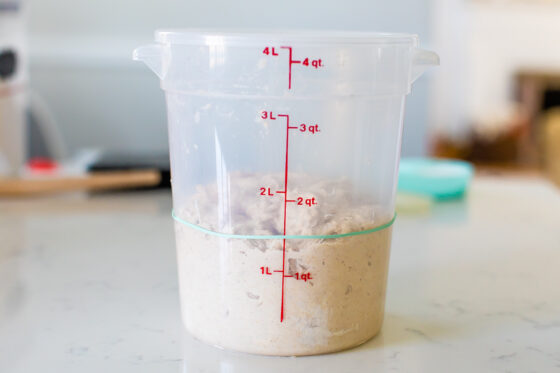
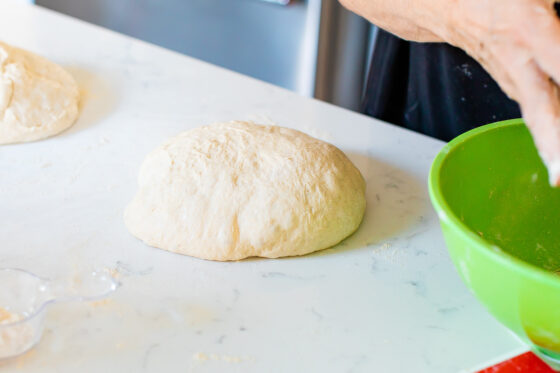
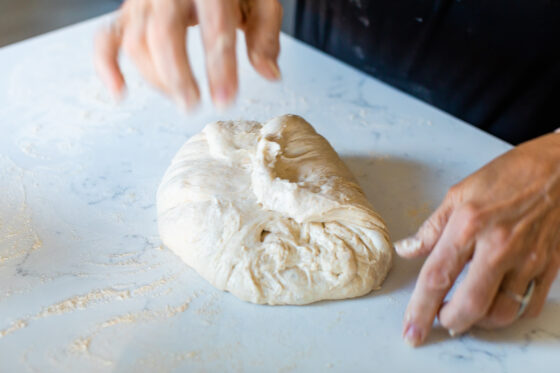
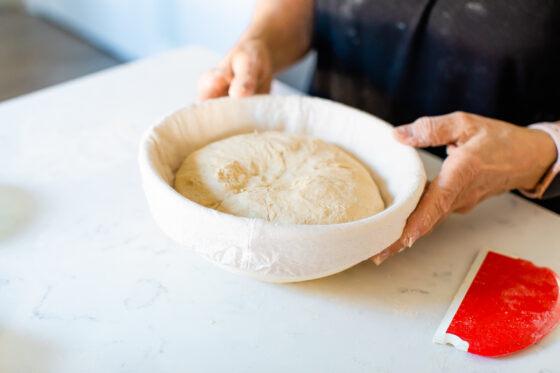
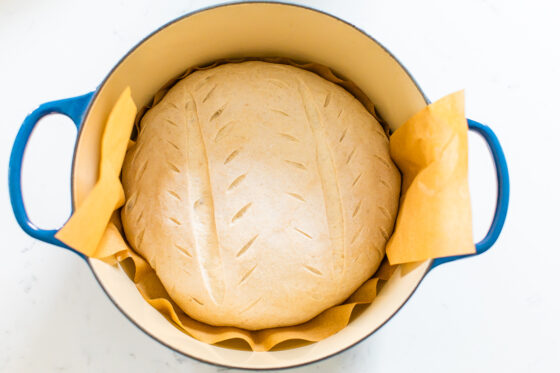
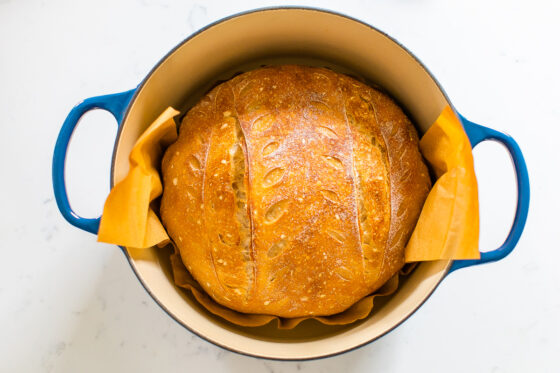
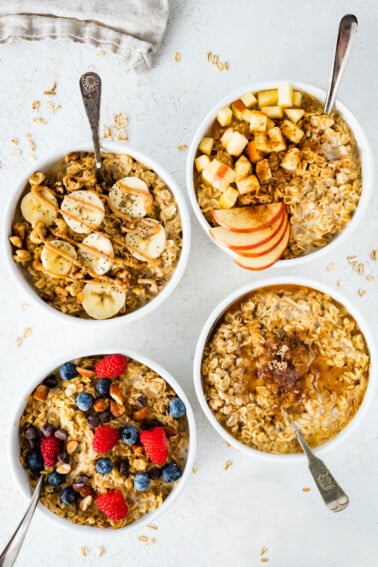
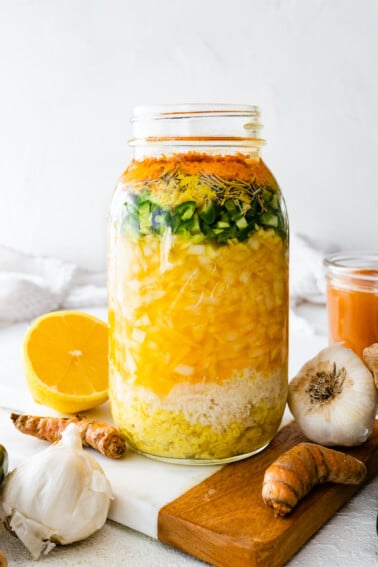
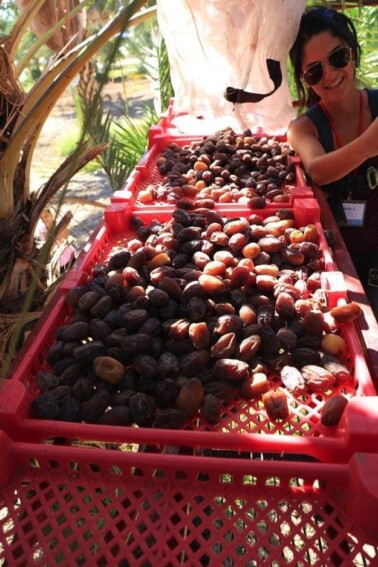
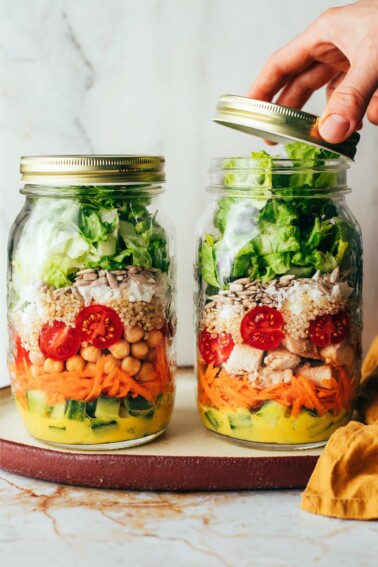
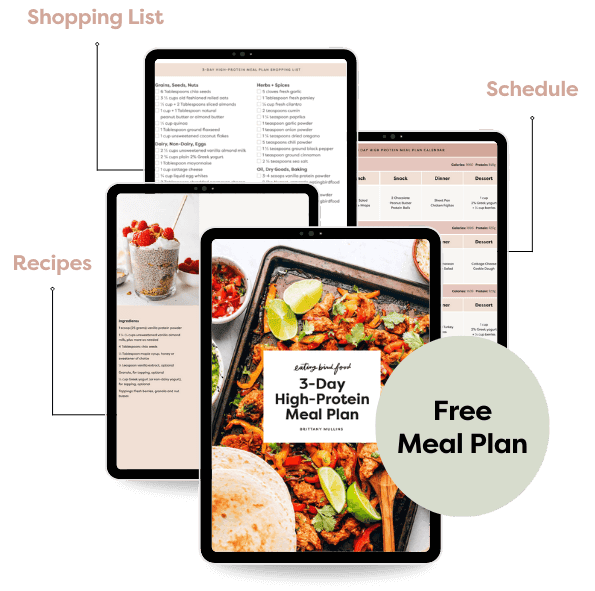






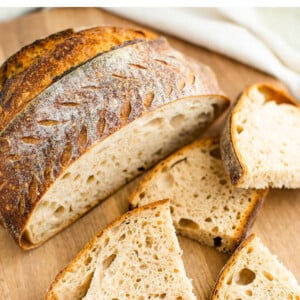
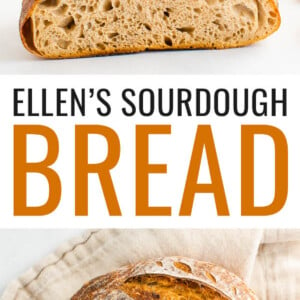
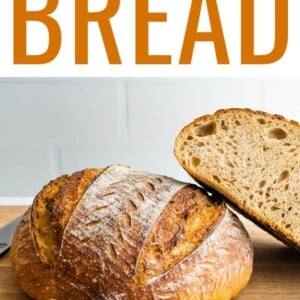
Mi first time making sourdough and my brother gave me some starter and told me to use your recipe as it is very easy to follow. I LOVE the simplicity of the recipe and the bread is amazing! Everyone comments on how great it looks and tastes. I just made my 3rd batch! Thank you!
Ahh this is seriously the best, Julie. I am so glad you and your brother found this recipe and it turned out great for you. Thank you so much for your review & star rating, it means so much to me!
I am not new to sourdough but this has quickly become my favorite recipe! I point all my friends here when sharing my starter with newbies. Thanks so much, Brittany and Ellen!
Wow! That means a lot, Sarah! Thank you for leaving a comment and review as well, I appreciate it!
Can you make this recipe in bread maker?
Hi Norma! There are some recipes for sourdough bread made in a breadmaker but I would seek out a recipe that specifically uses a breadmaker as we haven’t tested this recipe in one.
Hi Brittany, Happy New Year! I’m super excited to try this recipe! I have a question about step 7 on day one. It states to cover the bannetons and put them in the fridge. What do you suggest we cover them with? Is it loose cover or do they need to be sealed in something? Thanks for your help and sharing this recipe 🙂
Hi Raquel. Great question. I asked Ellen and here’s what she said. Most people use a grocery store plastic bag to cover them. I like to put a small tea towel over them so they’re not touching the grocery store bag and then cover it with the plastic bag. You want it covered but not an air-tight cover. If you don’t cover it at all it will dry out. Hope this helps.
Thank you so much for the help. I baked the loaves today and they are delicious! My family can’t stop eating it. My husband sneaks a slice every time he walks by the kitchen. I’m not sure how long they will last 🙂 Thanks again!
Ah yay! This makes me so happy to hear, Raquel. So pumped the bread was a hit. Thanks for the review!
Oh my goodness! It took some success and some fails but I think I have it figured out. I started with this Brittney and then went to You Tube and came back to this. Learning curve accomplished and I feel great about it. Thanks for the inspiration!
Yay! Happy to hear it was a success, Sharalee!
For Ellen sourdough recipe, can I use a sourdough starter right out of the fridge or do I have to feed it and let it rise before I use it?
Thank you
Hi Deborah! You should feed your starter and let it rise before using it for the recipe.